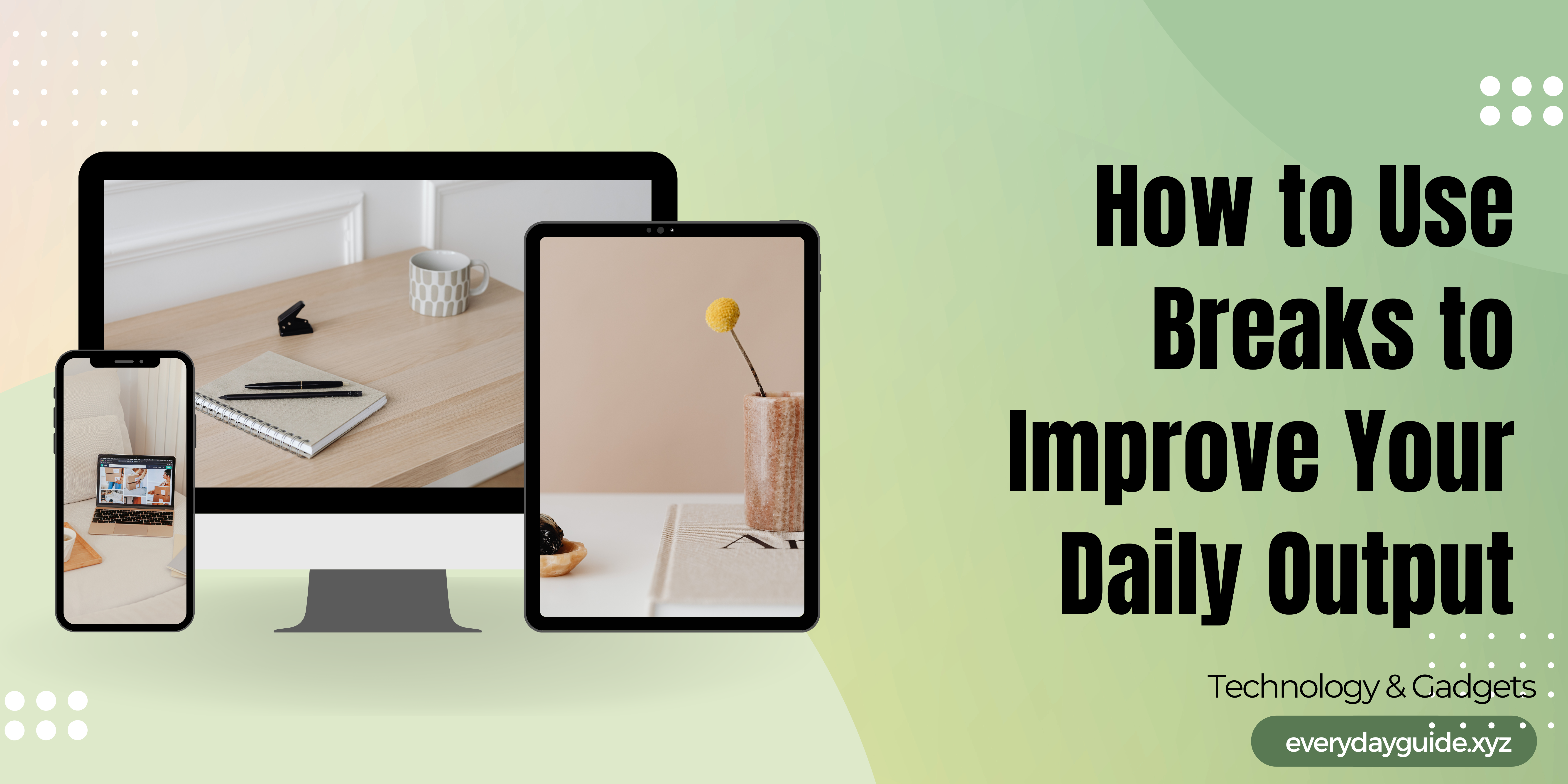With practical value paramount in our rapid-fire world, who could argue? The trouble is not a lot of people talk about the power in just getting up and taking a break. By knowing how to use breaks, your daily output can be improved, enhancing the focus, efficiency and performance of those around you. In this guide, we will discuss multiple techniques that have been tried and tested in scientific shoes on how to maximize your breaks to increase your productivity; so you can work smarter without having to work harder.
Breaks and Productivity: The Science behind it

In order to unlock the incredible power of breaks, you need to understand how it works behind the scenes. Science has proven that taking regular breaks makes us far more productive and less prone to burnout.
The Cognitive Load Theory
According to the cognitive load theory, our brains have only a limited capacity for processing information. We can use only so much of this cognitive capacity, and we burn out fast when we work for long periods without a break. Breaking things up helps to remove mental fatigue and allows us to get our mind back into gear. During this refilling interval, we get the stamina to come back again with recharged vigor and good emphasis.
Proven Technique: The Pomodoro Approach
The Pomodoro Technique is one of the top approaches for fitting breaks into your workflow. If you’re not familiar with this time-management technique, it’s where you work for a focused period of time — say 25 minutes — and then take the next five to relax. A cool down is done after four cycles, which is resting between of 15-30 minutes. The strategy uses the practice of regular breaks to keep energy levels high, intensity peak, and burnout low.
Kinds of breaks and their advantages

FluorPython has an updated article: Taking breaks, and we hope that understanding more about the 4 types of break your body needs will help you optimising working all day. Below are several different types of breaks and how to use them in order to remain the most productive:
Microbreaks
They are called microbreaks because they are the shortest. This is literally a break of 10 to 30 seconds — not minutes. These quick breaks need only be minimal — a stretch or a stand, perhaps even a couple of deliberate breaths. This will help to alleviate physical strain and mental fatigue, ensuring your body (back) is fresh on game day.
Regular Breaks
Where microbreaks only take a few seconds, regular breaks are between 5–15 minutes. You also usually use these times to get up from your workstation, you grab a snack or do something else. Breaks get you out of focus, they help you to prevent burning out especially if it will be a Someday activity.
Extended Breaks
Extended breaks: More extended periods of rest are given throughout the day such as lunch time or an afternoon rest period lasting 30 minutes and longer. These breaks provide much-needed rest and recuperation for your mind and body. They gives you a time to take a little break of your job that may give rise to better attention and creativity than before.
Break schedules for different work patterns
Here’s a table showing suggested break schedules for different work patterns based on typical work hours and industry best practices:
| Work Pattern | Total Work Hours | Break Schedule | Notes |
|---|---|---|---|
| Standard 8-Hour Workday | 8 hours | – 1st Break: 15 mins (Mid-morning) – Lunch: 30-60 mins (After 4 hours) – 2nd Break: 15 mins (Mid-afternoon) | Common in offices and retail environments. 30-60 minutes lunch break depending on policy. |
| 10-Hour Shift | 10 hours | – 1st Break: 15 mins (After 2 hours) – Lunch: 30-60 mins (After 5 hours) – 2nd Break: 15 mins (After 8 hours) | Longer shifts typically allow for more or slightly longer breaks. |
| 12-Hour Shift | 12 hours | – 1st Break: 15 mins (After 2 hours) – 2nd Break: 15 mins (After 5 hours) – Lunch: 30-60 mins (After 8 hours) – 3rd Break: 15 mins (After 10 hours) | Often used in healthcare, manufacturing, etc. Requires more breaks due to extended hours. |
| Part-Time (4-6 Hours) | 4-6 hours | – 1st Break: 15 mins (Mid-shift) – Optional Lunch: 30 mins (if shift is over 5 hours) | For shorter shifts, a single break and optional lunch may suffice. |
| Split Shift | Varies (Split into 2 sessions) | – Breaks depend on length of each shift segment. Typically: – 1st Break: 15 mins (During first session) – Lunch: 30 mins (Between sessions) – 2nd Break: 15 mins (During second session) | Used in industries like transportation, hospitality. Breaks adjusted to shift segments. |
| Night Shift (8 Hours) | 8 hours (Overnight) | – 1st Break: 15 mins (After 2 hours) – Lunch: 30-60 mins (Mid-shift) – 2nd Break: 15 mins (After 6 hours) | Night workers often need regular breaks to combat fatigue. |
| Flexible Hours (e.g., 9/80) | 9-hour days (with alternating short weeks) | – 1st Break: 15 mins (Mid-morning) – Lunch: 30-60 mins (After 5 hours) – 2nd Break: 15 mins (Mid-afternoon) | Workers do 9-hour shifts and have an extra day off every two weeks (e.g., a Friday off). |
Implementation of these Break patterns
The power of utilizing these break patterns is in adapting them to how you work and your schedule. If, for instance, you prefer to work in relatively long spans, then a longer amount of focused work with more breaks may be the way to go. Alternatively, if you prefer shorter and more frequent breaks, then the Pomodoro Technique might be more for you.
The Advantages of Sticking to a Perfect Breaking Scheme

Following these break timings can ultimately result in higher productivity, lower stress and increased job satisfaction. Using breaks as a part of your normal day will allow you to benefit from working on an item then stopping and resting, allowing yourself to decompress, gain focus when back at the task.
Also Read More:
- 15 Travel Tips And Tricks For Students With Low Budget
 You can travel as a student and not break the bank. Whether it is better planning, or also being a little wiser, there are many ways in which you can see the world as a gap year student without compromising on… Read more: 15 Travel Tips And Tricks For Students With Low Budget
You can travel as a student and not break the bank. Whether it is better planning, or also being a little wiser, there are many ways in which you can see the world as a gap year student without compromising on… Read more: 15 Travel Tips And Tricks For Students With Low Budget - Easy Packing Hacks to Save Space in Your Suitcase
 How to Fit Unbelievable Amounts of Technical Offroad and Overland Gear into your Bags Maximize the space in your bag, to minimalize the stress of packing for a trip How to pack effectively, save space and not even get clothes wrinkled… Read more: Easy Packing Hacks to Save Space in Your Suitcase
How to Fit Unbelievable Amounts of Technical Offroad and Overland Gear into your Bags Maximize the space in your bag, to minimalize the stress of packing for a trip How to pack effectively, save space and not even get clothes wrinkled… Read more: Easy Packing Hacks to Save Space in Your Suitcase - How to Pack a Carry-On Like a Pro in 5 Simple Steps
 It has been a complete game-changer to pack less and go the carry-on route. It saves you time at the airport, and it also simplifies any trip to your destination. Have you ever wanted to learn how to pack a carry… Read more: How to Pack a Carry-On Like a Pro in 5 Simple Steps
It has been a complete game-changer to pack less and go the carry-on route. It saves you time at the airport, and it also simplifies any trip to your destination. Have you ever wanted to learn how to pack a carry… Read more: How to Pack a Carry-On Like a Pro in 5 Simple Steps - How to Keep Your Clothes Wrinkle-Free While Traveling
 As thrilling as traveling can be, the reality is that removing wrinkles from clothing while on the move remains among the popular problems travelers encounter. There is nothing worse than setting out for a busy day in a new city or… Read more: How to Keep Your Clothes Wrinkle-Free While Traveling
As thrilling as traveling can be, the reality is that removing wrinkles from clothing while on the move remains among the popular problems travelers encounter. There is nothing worse than setting out for a busy day in a new city or… Read more: How to Keep Your Clothes Wrinkle-Free While Traveling - How to Travel Cheap Without Sacrificing Fun
 One of the most enriching experiences in life happens to be traveling, but it always seems as though travel comes at a steep price. But it is possible to travel and have fun on a tight budget with some creativity and… Read more: How to Travel Cheap Without Sacrificing Fun
One of the most enriching experiences in life happens to be traveling, but it always seems as though travel comes at a steep price. But it is possible to travel and have fun on a tight budget with some creativity and… Read more: How to Travel Cheap Without Sacrificing Fun
How to Build Breaks into Your Work Day
Integrating breaks into your workday means carefully considering how you break and with consistency Some tangible suggestions to help you get the most out of these breaks are below.
Set a Timer for Breaks
You can even use a timer to get helpful reminders to get yourself out of the way and take some breaks! Timing intervals allows you to time your breaks so that you remember to step away from your work, as well as keep the breaks within a structured approach.
Develop A Break-friendly Environment
Having a proper relaxation zone or break room can help in making your breaks more effective. This is a place where you should be as free of work distractions as possible so that way you can fully unplug.
Take Time for Physical Activity
Adding some movement during your breaks can be even more advantageous. There are short walks, stretches and the like during breaks: they are said to increase energy levels, get the circulation going again and bring other physical well-being.
Clichéd errors to avoid while taking a break
While these breaks are important, there are some mistakes that can ruin their effectiveness. Understanding these and how to avoid them can help you get the most out of your breaks.
Over-Scheduling Breaks
One thing you have to be careful of is scheduling too many breaks and making them disrupt your workflow. This means you have to balance your work with breaks that give relief but still help you come back refreshed and new.
Using Breaks Ineffectively
If you spend your break doing things that are cognitive taxing (work emails or personal problems), it counteracts the recovery effects of taking an actual pause. Take rest, doing activities force yourself to do.
Skipping Breaks Altogether
Not taking breaks at all to be more productive can cause you to burn, out and in the end result in lower overall output. Take regular breaks – this is essential to keeping you both productive and sane in the long run.
Conclusion: Closing Note: The Best Timeout Strategy to Reclaim Productivity
Learn to Take Breaks — a Key Element of Optimal Work Performance Different Types of Breaks to TakeOptimal Break SchedulesCommon MistakesWhat You Can Do With This InformationBy being more thoughtful and strategic about which breaks you take and when, you can actually increase your productivity while also reducing stress. Apply these two components into your routine, and notice how your productivity sky-rockets.

